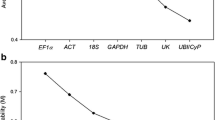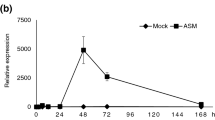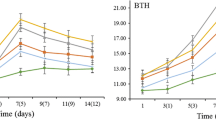Abstract
Fire blight disease caused by Erwinia amylovora is one of the most important bacterial diseases of apple and pear world-wide. DL-3-aminobutyric acid (BABA; 1.0 mg ml−1) and acibenzolar-S-methyl (ASM; 0.1 mg ml−1) were applied as foliar treatments on apple seedlings at various days before inoculation (dbi) either alone or in combination at different time sequences. Asm was slightly more effective than Baba in controlling fire blight disease expressed as browning discolouration index (BDI) and stem bending index (Sbi). Combined treatments in sequence with BABA/ASM drastically reduced disease expression (BDI 98.1%, SBI 97.8%) for a long period and proved to be more effective than the other treatments. The highest degrees of induced resistance were obtained when Baba and Asm were applied in sequence 4 and 2 dbi or 6 and 4 dbi, respectively. The resistance inducing effects gradually decreased when the period of time between treatment and inoculation increased. Peroxidase (PO) activities increased more markedly in inoculated leaf tissues treated with ASM and BABA/ASM than in BABA-treated plants and in inoculated control tissues. Inoculated or not inoculated apple seedlings treated with BABA alone or combined with ASM (BABA/ASM) revealed the highest levels of both total and free salicylic acid (Sa) in leaf tissues. Moreover, in leaf tissue treated with the combination Baba/Asm the lowest number of bacterial cells was determined.
Zusammenfassung
Feuerbrand, hervorgerufen durch Erwinia amylovora, gehört weltweit zu den bedeutendsten Bakterienkrankheiten an Apfel und Birne. Apfelsämlinge wurden im Sprühverfahren mit DL-3-Aminobuttersäure (BABA; 1,0 mg ml−1) und Aciben-zolar-S-methyl (ASM; 0,1 mg ml−1) an unterschiedlichen Tagen vor Inokulation (dbi) entweder allein oder in Kombination in verschiedener zeitlicher Sequenz behandelt. Hinsichtlich der Unterdrückung der Feuerbrandsymptome, die als Blattverbräunungsindex (BDI) und Stängelkrümmungsindex (SBI) ausgewertet wurden, erwies sich ASM als etwas stärker wirksam als BABA. Kombinierte Behandlung mit BABA/ASM in Sequenz verminderte drastisch den Krankheitsbefall (BDI 98,1%, SBI 97,8%) während einer langen Zeitspanne und erwies sich als wirksamer als die übrigen Behandlungen. Die stärkste Resistenz-induzierende Wirkung wurde erzielt, wenn BABA und ASM in Sequenz 4 und 2 dbi oder 6 und 4 dbi angewendet wurden. Die Resistenz-induzierende Wirkung verminderte sich bei zunehmender Zeitspanne zwischen Behandlung und Inokulation. Peroxidase (PO)-Aktivitäten nahmen in inokulierten Blattgeweben, die mit ASM und BABA/ASM behandelt worden waren, stärker zu als in BABA-behandelten Pflanzen und inokulierten Kontrollgeweben. Inokulierte oder nicht inokulierte Apfelsämlinge, die mit BABA allein oder in Kombination mit BABA/ASM behandelt worden waren, zeigten in den Blattgeweben die höchsten Gehalte an gesamter und freier Salicylsäure (SA). Darüber hinaus wurde in BABA/ASM-behandelten Blättern die niedrigste Zahl an Bakterienzellen nachgewiesen.
Similar content being viewed by others
Literature
Baysal, O., P. Laux, W. Zeller, 2002: Systemic acquired resistance (SAR)-effect of BTH against fire blight. Acta Hort. 590, 269–272.
Beer, S.V., T.M. Sjulin, H.S. Aldwinckle, 1983: Amylovorin-in-duced shoot wilting: Lack of correlation with susceptibility to Erwinia amylovora. Phytopathology 73, 1328–1333.
Bereswill, S., S. Jock, P. Bellemann, K. Geider, 1998: Identification of Erwinia amylovora by growth morphology on agar containing copper sulfate and by capsule staining with lectin. Plant Dis. 82, 158–164.
Bradford, M.M., 1976: A rapid and sensitive method for the quantification of microgram quantities of protein utilizing the principle of protein-dye binding. Anal. Biochem. 72, 248–254.
Chamsai, J., J. Siegrist, H. Buchenauer, 2004: Mode of action of resistance-inducing 3-aminobutyric acid in tomato roots against Fusarium wilt. J. Plant Dis. Protect. 111, 273–291.
Cohen, Y.R., 2002: β-Aminobutryric acid-induced resistance against plant pathogens. Plant Dis. 86, 448–457.
Cohen, Y., T. Niderman, E. Mossinger, R. Fluhr, 1994: β-Aminobutyric acid induces the accumulation of pathogenesis-related proteins in tomato (Lycopersicon esculentum L.) plants and resistance to late blight infection caused by Phytophthora infestans. Plant Physiol. 104, 59–66.
Conrath, U., C.M. Pieterse, B. Mauch-Mani, 2002: Priming in plant-pathogen interactions. Trends Plant Sci. 7, 210–216.
El-Goorani, M.A., H.M. El-Kasheir, A.A. Shoeib, F.M. Hassanein, 1989: Distribution of streptomycin resistant strains of Erwinia amylovora in Egypt during 1988: J. Phytopathol. 127, 69–74.
Faize, M., L. Faize, N. Koike, M. Ishizaka, H. Ishii, 2004: Aciben-zolar-S-methyl-induced resistance to Japanese pear scab is associated with potentiation of multiple defense responses. Phytopathology 94, 604–612.
Friedrich, L., K. Lawton, W. Ruess, P. Masner, N. Specker, M. Gut Rella, B. Meier, S. Dincher, T. Staub, S. Uknes, J. Métraux, H. Kessman, J. Ryals, 1996: A benzothiadiazole derivative induces systemic acquired resistance in tobacco. Plant J. 10, 61–70.
Halbwirth, H., W. Kampan, K. Stich, T.C. Fischer, B. Meisel, G. Forkmann, W. Rademacher, 2002: Biochmical and molecular biological investigations with respect to induction of fire blight resistance in apple and pear by transiently altering the flavonoid metabolism with specific enzyme inhibitors. Acta Hort. 590, 485–492.
Hammerschmidt, R., E.M. Nuckles, J. Kuc, 1982: Association of enhanced peroxidase activity with induced systemic resistance of cucumber to Colletotrichum lagenarium. Physiol. Plant Pathol. 20, 73–82.
Hammerschmidt, R., 1999: Induced disease resistance: How do induced plants stop pathogens? Physiol. Mol. Plant Pathol. 55, 77–84.
Jakab, G., V. Cottier, V. Toquin, G. Rigoli, L. Zimmerli, J.-P. Métraux, B. Mauch-Mani, 2001: β-Aminobutyric acid-induced resistance in plants. Eur. J. Plant Pathol. 107, 29–37.
Jeun, Y.C., H. Buchenauer, 2001: Infection structures and localization of the pathogenesis-related protein AP24 in leaves of tomato plants exhibiting systemic acquired resistance against Phytophthora infestans after pre-treatment with 3-aminobutyric acid or tobacco necrosis virus. J. Phytopathol. 149, 141–153.
King, E.O., M.K. Ward, D.E. Raney, 1954: Two simple media for the demonstration of pyocyania and fluorescein. J. Lab. Clin. Med. 44, 301–307.
Kunz, W., R. Schurter, T. Maetzke, 1997: The chemistry of benzothiadiazole plant activators. Pestic. Sci. 50, 275–282.
Lawton, K.A., L. Friedrich, M. Hunt, K. Weymann, T. Delaney, H. Kessmann, T. Staub, J. Ryals, 1996: Benzothiadiazole induces disease resistance in Arabidopsis by activation of the systemic acquired resistance signal transduction pathway. Plant J. 10, 71–82.
Malamy, J., D.F. Klessig, 1992: Salicylic acid and plant disease resistance. Plant J. 2, 643–654.
Manulis, S., D. Zutra, F. Kleitman, I. David, M. Zilberstaine, 1999: Streptomycin resistance of Erwinia amylovora in Israel and occurrence of fire blight in pear orchards in the autumn. Acta Hort. 489, 85–87.
Maxson-Stein, K., S.-Y. He, R. Hammerschmidt, A.L. Jones, 2002: Effect of treating apple trees with acibenzolar-S-methyl on fire blight and expression of pathogenesis-related protein genes. Plant Dis. 86, 785–790.
Norelli, J.L., A.L. Jones, H.S. Aldwinckle, 2003: Fire blight management in the 21st century: using new technologies that enhance host resistance in apple. Plant Dis. 88, 756–765.
Norelli, J.L., J.D. Gilpatrick, 1982: Techniques for screening chemicals for fire blight control. Plant Dis. 66, 1162–1165.
Oostendorp, M., W. Kunz, B. Dietrich, T. Staub, 2001: Induced disease resistance in plants by chemicals. Eur. J. Plant Pathol. 107, 19–28.
Reuveni, M., T. Zahavi, Y. Cohen, 2001: Controlling downy mildew (Plasmopara viticola) in field-grown grapevine with β-aminobutryic acid (BABA). Phytoparasitica 29, 125–133.
Roemmelt, S., J. Plagge, D. Treutter, M. Gutmann, W. Feucht, W. Zeller, 1999: Defence reaction of apple against fire blight: Histological and biochemical studies. Acta Hort. 489, 335–336.
Ryals, J.A., U.H. Neuenschwander, M.G. Willits, A. Molina, H.Y. Steiner, M.D. Hunt, 1996: Systemic acquired resistance. Plant Cell 8, 1809–1819.
Schilli, E., 1986: Untersuchungen zur Epidemiologie, Prognose und Bekämpfung des Feuerbrandes an Kernobst, verursacht durch Erwinia amylovora (Burr.) Winslow et al. PhD thesis, Universität Hohenheim.
Sholberg, P.L., K.E. Bedford, P. Haag, P. Randall, 2001: Survey of Erwinia amylovora isolates from British Columbia for resistance to bactericides and virulence on apple. Can. J. Plant Pathol. 23, 60–67.
Siegrist, J., M. Orober, H. Buchenauer, 2000: β-Aminobutyric acid-mediated enhancement of resistance in tobacco to tobacco mosaic virus depends on the accumulation of sali-cylic acid. Physiol. Mol. Plant Pathol. 56, 95–106.
Sticher, L., B. Mauch-Mani, J.P. Métraux, 1997: Systemic acquired resistance. Annu. Rev. Phytopathol. 35, 235–270.
Thomson, S.V., M.N. Brisset, R. Chartier, J.P. Paulin, 1999: Induced resistance in apple and pear seedlings to fire blight by Bion® and correlation with some defense-related enzymes. Acta Hort. 489, 583–588.
Vanneste, J.L., 2000: Fire Blight: The Disease and its Causative Agent, Erwinia amylovora. CABI Publishing, Wallingford, UK.
Ye, X.S., S.Q. Pan, J. Kuc, 1990: Association of pathogenesis-related proteins and activities of peroxidase, β-1,3-glucanase, and chitinase with systemic induced resistance to blue mould of tobacco but not to systemic tobacco mosaic virus. Physiol. Mol. Plant Pathol. 36, 523–531.
Zeller, W., V. Zeller, 1999: Control of fire blight with the plant activator Bion®. Acta Hort. 489, 639–645.
Zimmerli, L., J.P. Métraux, B. Mauch-Mani, 2001: β-Aminobutyric acid-induced protection of Arabidopsis against the necrotrophic fungus Botrytis cinerea. Plant Physiol. 126, 517–523.
Author information
Authors and Affiliations
Rights and permissions
About this article
Cite this article
Hassan, M., Buchenauer, H. Induction of resistance to fire blight in apple by acibenzolar-S-methyl and DL-3-aminobutyric acid. J Plant Dis Prot 114, 151–158 (2007). https://doi.org/10.1007/BF03356211
Received:
Accepted:
Published:
Issue Date:
DOI: https://doi.org/10.1007/BF03356211
Key words
- acibenzolar-S-methyl (ASM)
- DL-3-aminobutyric acid (BABA)
- fire blight
- peroxidase (PO)
- salicylic acid (SA)




